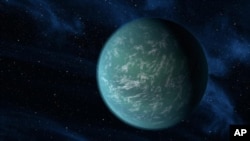Astronomers working with NASA's orbiting Kepler space telescope say they have discovered the smallest and most Earth-like planet ever seen outside our solar system. They say it orbits a sun-like star in the so-called “habitable zone” - a distance from the parent star where moderate temperatures on the planet would make liquid water - and life - possible.
The newly found planet, named Kepler-22b - is one of a growing inventory of nearly 50 newly discovered super-Earth planets orbiting neither too close nor too far from their parent stars and where conditions might exist that could support life.
Kepler-22b is 600 light years away - meaning it would take a light beam from Earth 600 years to reach it. But even at that enormous distance, the Kepler astronomers were able to discern that the planet is about 2.4 times the diameter of Earth, orbits its sun in an Earth-year-like 290 days, and because of its mid-range location in the "habitable zone," probably enjoys balmy daytime temperatures of around 22 degrees Celsius.
But Jon Jenkins, co-investigator for data analysis with the Kepler mission, says it is not yet known whether the surface of Kepler-22b is rocky like Earth and could actually support life.
“Although this planet is over twice the size of the Earth, if it were indeed rocky, you could have liquid water pooling on the surface," said Jenkins. "And as far as we know, liquid water is required by all life that we know about. So, it’s an incredibly necessary ingredient for life as we know it.”
Kepler-22b has been formally confirmed by other telescopes. The Kepler team says it has discovered nearly 1,100 candidate exoplanets with the aid of the sharp-eyed space telescope.
Kepler is currently scanning a narrow segment of the cosmos, continuously observing an estimated 150,000 stars within the segment for orbiting planets.
Jon Jenkins says he is thrilled by the discovery of Kepler-22b, after years of searching for Earth-like planets.
“It’s great to be at this point where we have this milestone of finding this first super-Earth planet in the habitable zone of a sun-like star," he said.
Jenkins says it will be up to future missions and more powerful telescopes to determine if there actually is life on Kepler-22b and the other exoplanets, but Jenkins says as more data is gathered on these distant worlds, life beyond Earth seems increasingly in the realm of possibility.
Space Telescope Spots 'Earth-Like' Planet 600 Light Years Away









